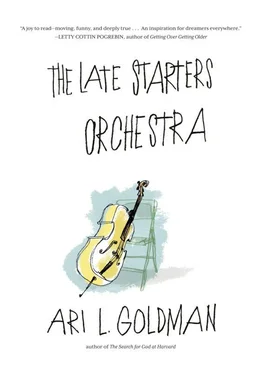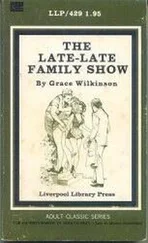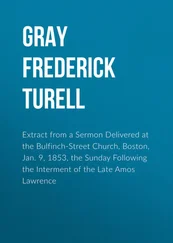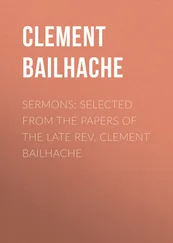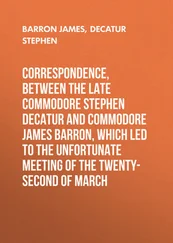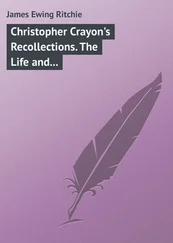Judah laughed. Dominic smiled, raised his baton, and the music started. Well, it sounded like music but soon deteriorated into cacophony. Everything went awry, even the vibrato. The cellos were way ahead of the violins and no one was in tune. “Why are you racing ahead?” he asked the cellos. “Okay. Who started it? Who is the ringleader? There’s always a ringleader. Raise your hand if you are the ringleader.” No one did.
Dominic scowled. “Good. You already know the first orchestra rule. It goes like this: If you make a mistake and the conductor asks, ‘Who was that?’ say, ‘It wasn’t me!’ Blame someone else.”
I watched Judah to see if he was mortified or amused. He was laughing so hard he could hardly play.
Judah’s “repertory class” was taught by Nancy, a tall and lanky woman with big hands who seemed born to play the cello. She towered over the little children in the room even when she sat down. Her cello seemed formidable. The children, with half-size and quarter-size instruments, sat in front of her. A group of parents, some with notebooks open, ringed the room. Nancy put everyone at ease by having the children bang out tunes on their cellos and strum them like guitars. She had them play certain pieces together and then sent the parents out of the room. “That’s new for Suzuki,” one mother commented as we filed out and stood in the hall. (Suzuki seemed to have a never-ending appetite for parent involvement.)
Thirty minutes later we were invited to return and, after we took our seats, the children treated us to a “concert” of songs that they learned in our absence. It was a way of moving both the kids and us parents toward musical independence.
Later, a cellist named Rick held a “master class” that was limited to four students. It took me awhile to understand his method. He began by zeroing in on one child, asking him or her to play the newest piece of music they were working on. He’d wrinkle his brow and then pick out one aspect of their technique — the way she was holding the bow, the way he was sitting, the way her thumb grasped the neck of the cello — and have them repeat the music. He’d make the slightest correction and then ask them to play again. “Good. Much better,” he’d say.
There are so many moving parts when it comes to playing the cello. First there is the human body, starting with the ten fingers, all of which are engaged in some way with the instrument. The cellist’s feet must be planted firmly on the ground, the butt on the chair sitting at a right angle to the back, the arm grasping the bow yet flexible enough to reach across the full range of four strings. Then, there is the cello itself with the four pegs that are used for tuning and the metal end pin on which the instrument pivots when played.
Rick felt that Judah’s left shoulder was too high. “You’re tensing up. No need to do that. Just drop your shoulder down,” he said. He gave Judah a good way to remember to do this. “Before you begin, raise your shoulder to your ear and then drop it down. Raise it and drop it. Good, that’s it. Now pick up your bow.”
I watched Judah and saw that it was difficult for him to keep the shoulder low. He did his best but it kept rising. Watching him, I felt a sympathetic pain. I rubbed my neck, silently hoping that he would master this so we’d both feel better.
It wasn’t all technique. Rick soon turned his attention to the other young players in the room as if noticing for the first time that they were there. But the focus was still on Judah. “What did you think of Judah’s playing?” he asked.
“It was bouncy,” one girl said.
“Good shifting,” said another.
“Judah was having a good time,” a boy said.
Now, with the new round of correction, critique, and encouragement, the child would play the piece again. After fifteen minutes, Rick would gently move on to the next young cellist. And the process of music, correction, encouragement, and group critique would begin again.
Rick’s questions to the group would vary as the week went on. “What food did Sarah’s piece sound like?” he’d ask. “Like chocolate,” said one child. “Like juicy red meat,” said another.
“What color?” “Red.” “Purple.” “Green.” “Snow!”
Time whisked by. Judah played cello a good five hours a day for five days straight and didn’t complain, even when I reminded him during a break that we’d have to spend a few minutes practicing. In the evening, the children put down their instruments and the faculty made music. One night a teacher played a gypsy-like piece by Ravel that began on stage but soon had her dancing through the audience of children.
“What did that make you feel like?” she asked the children when she was done. By this time they were more than musicians; they were experienced critics who could express their feelings about the music. The answers were so sophisticated that they took my breath away.
“It made me feel like crying,” said one little boy.
“No. It was happy,” said another child.
“Well, kind of happy and sad, like flying. It’s exciting but scary.”
“I felt something different,” said another. “It was like. . like rolling down a hill so fast, you can’t stop!”
Suzuki camp introduced me to the musical equivalent of the Soccer Mom, that devoted and sometimes pushy parent who, the stereotype goes, spends most of her time in the family minivan ferrying her offspring to soccer games and arguing with the coach for preferential treatment for her kids. Instead of carrying extra sneakers, socks, shin guards, and jerseys, the Cello Mom will carry a small stool (little cellists need little chairs), rosin (a chemical mixture rubbed on the bow to increase friction), extra strings, and sheet music. Between sessions at Suzuki camp, legions of music moms and dads — and sometimes grandparents, aunts, and uncles — could be seen toting the musical paraphernalia. Every child had a chaperone.
Some parents were musicians but this was not about their own playing. If any parents brought instruments along to Suzuki camp they didn’t show them in public. The only taste of music-making we parents experienced was the “group singing chorus” where parents and children were encouraged to do voice exercises and sing together. Judah and I went once to the group singing chorus but found it totally boring. We were already musically bonded so we decided to cut that class.
Parents were expected to attend all classes with their children, except for orchestra. While the kids were in orchestra, we parents were encouraged to come to special classes about how to be a good Suzuki parent. There were sessions on such topics as “How to Encourage Good Practicing Habits,” “How to Create a Music-Friendly Home Environment,” and “What to Do When Johnny Wants to Quit.”
We gathered in a classroom on an upper floor of the Hartt School while our musical prodigies were in the studios below. It was a diverse crowd, although older parents, almost all of them women, tended to predominate. There weren’t too many young moms in their twenties with a brood of kids. This was more the domain of the privileged older parent with one or at most two children, kids whom they could dote on. And while this was a BlackBerry and cell-phone crowd, parents paid attention. They did not pull out their PDAs. They had invested in their child’s musical education and recognized that it wouldn’t happen without them.
What inspires such parental devotion?
I am not sure about other parents, but for me it was a combination of emotions: the pleasure of the music, of course, but also anger and sadness. Simply put, I wish someone had done this for me. When I was six and seven and eight why didn’t anyone nurture my musical gifts? I sang in school plays and in the synagogue, and I never tired of listening to music and watching musicians make music, either on television or live. Why didn’t someone put a violin or cello in my hands? Why didn’t my parents take me to music lessons? Why didn’t they present me with the challenges of musical notation and vibrato and the camaraderie of the orchestra?
Читать дальше
